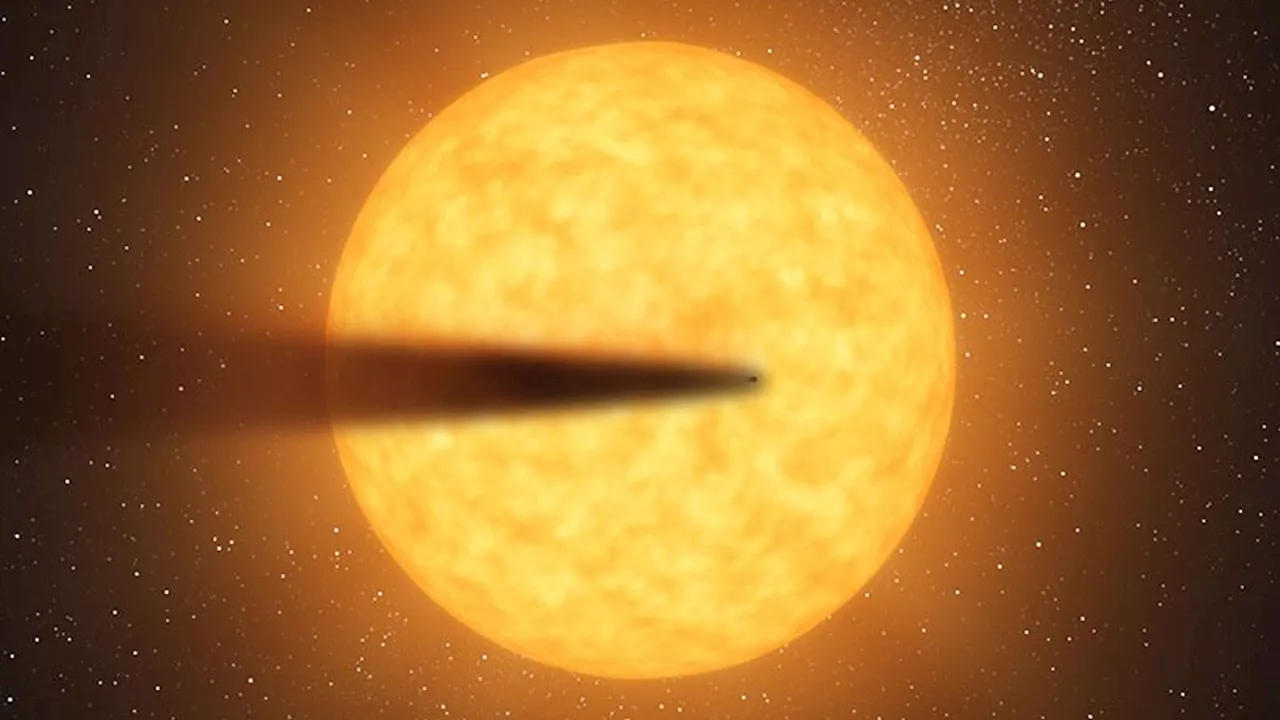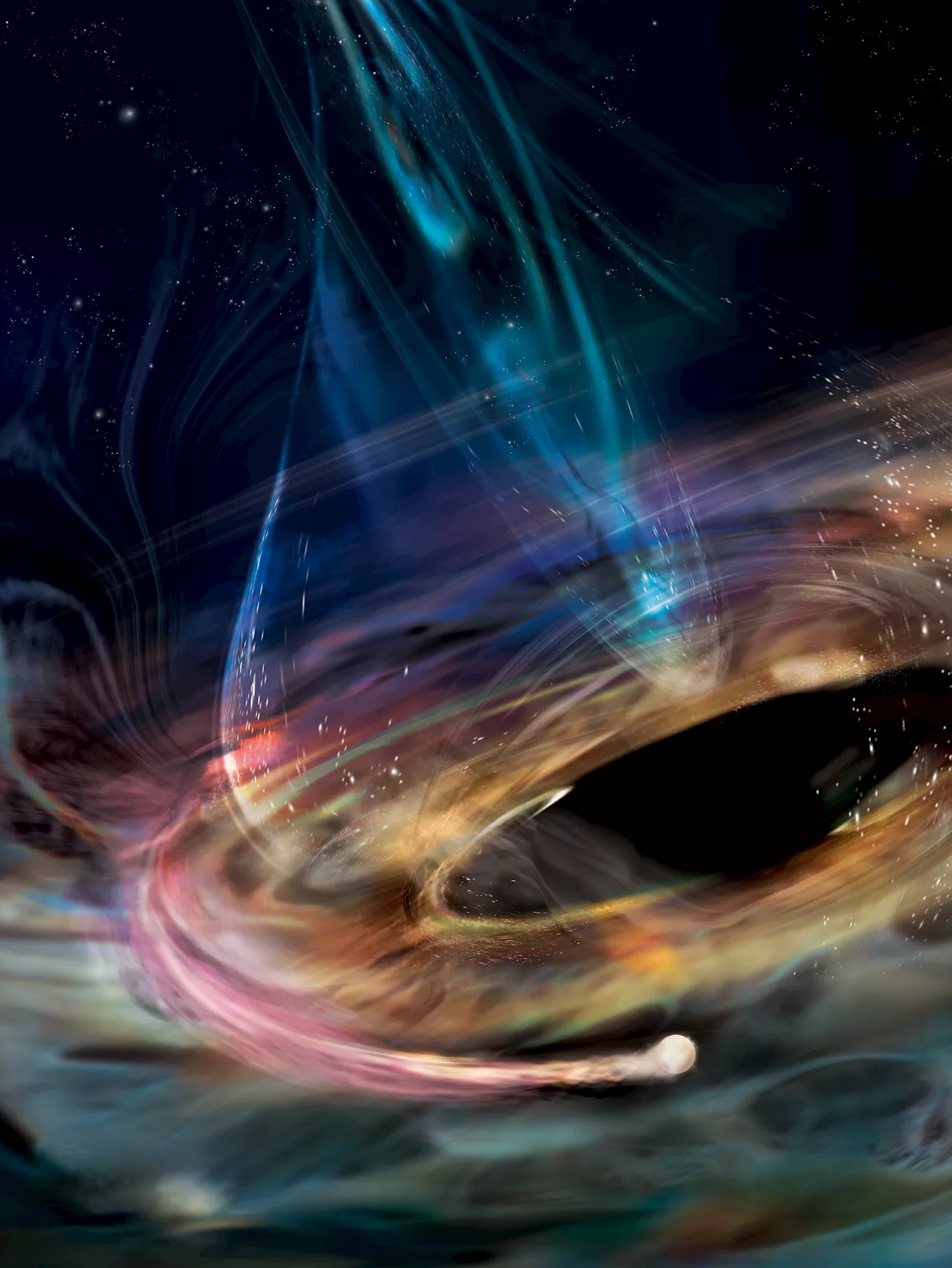For the first time, scientists have directly observed the real-time formation of plasma jets emanating from a supermassive black hole. This groundbreaking observation, made using the Very Long Baseline Array (VLBA), provides valuable insights into the behavior of these enigmatic objects and the processes that drive the launch of relativistic jets.
An artist's impression portrays a white dwarf embedded in the disk of a giant black hole. Credit: NASA/Sonoma State University, Aurore Simonnet (SMBH) located in a galaxy 270 million light-years away in the constellation Draco. For years, this galaxy (1ES 1927+654) has been the focus of attention because of the (AGN) at its core. It all began in 2018 when the SMBH’s X-ray corona mysteriously disappeared, followed by a major outburst in the optical, ultraviolet, and X-ray wavelengths.
Astronomers began watching it closely, but what they saw next was completely unexpected! Much of the excitement was generated by the SMBH’s behavior, which suggested it was consuming a stellar remnant (a white dwarf). In addition, astronomers noted a huge increase in radio emissions and the formation of plasma jets extending from the black hole, which all happened over the course of a year. In this active galaxy 1ES 1927+654 (circled in green) harbors a central black hole weighing about 1.4 million solar masses and is located 270 million light-years away. (NASA/GSFC) Astronomers have observed jets emanating from the poles of several SMBHs in the Universe. Some of these have been shown to accelerate gas and dust particles to close to the speed of light, leading to the term “relativistic jets.” In some cases, astronomers have observed jets extending for thousands or even hundreds of thousands of light-years from their host galaxy. These jets blast material across these distances, and some even trigger the formation of new stars.In this case, the jet appeared after a period of variable activity in 1ES 1927+654, where the AGN began consuming more material and becoming 100 times brighter over the course of a few months – a change that normally takes thousands or millions of years. After nearly a year of extremely high X-ray emissions, the black hole quieted down again in 2020, only to increase its output again in 2023. At the same time, it began emitting radio waves at 60 times the previous intensity over just a few months, something that has never before been monitored in real time for an SMBH. Using the Very Long Baseline Array (VLBA), the team obtained high-resolution radio imaging of the SMBH at the center of 1ES 1927+654. These observations clearly showed a pair of plasma jets forming around both poles of the black hole and expanding outward between 2023 and 2024. In recent years, scientists have identified “changing-look AGNs,” supermassive black holes that become far more active at radio frequencies from when they were first observed. In those instances, astronomers naturally assumed that something must have happened in between since their observations were years or decades apart. This is the first instance where astronomers saw this change happening in real time, thereby offering clues as to how these changes happen. As Meyer stated, “We have very detailed observations of a radio jet ‘turning on’ in real-time, and even more exciting are the VLBI observations, which clearly show these plasma blobs moving out from the black hole. That shows us that this really is an outflow jet of plasma that’s causing the radio flare. It’s not some other process causing increased radio emission. This is a jet moving at likely 20 to 30 percent of the speed of light originating very near a black hole. That’s the exciting thing.” Radio images of 1ES 1927+654 reveal emerging structures that appear to be jets of plasma erupting from both sides of the galaxy’s central black hole following a strong radio flare. Credit: NSF/AUI/NSF NRAO/Meyer at al. 2025 While these newly-forming jets are relatively small compared to the massive jets observed from some of the most powerful AGNs in the galaxy, they are likely to be more common across the Universe. While the largest jets extend far beyond their host galaxies and last for millions of years, scientists have become aware of smaller, shorter-lived jets – what they call “compact symmetric objects” (CSOs). In this sense, the jets observed in 1ES 1927+654 could represent a unique opportunity to learn more about how these structures form and grow with time. Similarly, astronomers will keep an eye on this galaxy and its SMBH because of the tidal disruptions that could indicate the presence of a. Meyer and his team have also suggested that the appearance of these jets may be associated with “a single ingestion of a star or a gas cloud” and that a single tidal disruption event may be what powers short-term CSOs (for maybe 1,000 years, they venture). “We still don’t really understand after all these decades of studying these sources why only a fraction of accreting black holes produce jets and then exactly how they launch them. Until recently we could not literally look into that innermost region to see what’s happening—how the accretion disk surrounding the black hole is interacting with and producing the jet. And so there are still a lot of open questions there.” While many unanswered questions still exist, several promising models exist for how jets might for
Supermassive Black Hole Plasma Jets Relativistic Jets Active Galactic Nuclei Changing-Look AGN
United States Latest News, United States Headlines
Similar News:You can also read news stories similar to this one that we have collected from other news sources.
 Astronomers observe real-time formation of black hole jets for the first timeIn 2018, a galaxy about 270 million light-years away from Earth exhibited a major increase in activity. It quieted down again by 2020 -- only to dramatically increase its output again in 2023.
Astronomers observe real-time formation of black hole jets for the first timeIn 2018, a galaxy about 270 million light-years away from Earth exhibited a major increase in activity. It quieted down again by 2020 -- only to dramatically increase its output again in 2023.
Read more »
 Astronomers Witness Fastest Disintegrating Planet Ever SeenUsing NASA's TESS telescope, astronomers have discovered a planet named BD+05 4868 Ab that is rapidly disintegrating due to bombardment from its star. The planet is losing a 'moon's worth' of matter every million years and is expected to vanish entirely soon. This discovery provides a unique opportunity to study the composition of planets orbiting other stars.
Astronomers Witness Fastest Disintegrating Planet Ever SeenUsing NASA's TESS telescope, astronomers have discovered a planet named BD+05 4868 Ab that is rapidly disintegrating due to bombardment from its star. The planet is losing a 'moon's worth' of matter every million years and is expected to vanish entirely soon. This discovery provides a unique opportunity to study the composition of planets orbiting other stars.
Read more »
 A crumbling exoplanet spills its gutsAstronomers have determined the internal composition of a distant, disintegrating planet for the first time.
A crumbling exoplanet spills its gutsAstronomers have determined the internal composition of a distant, disintegrating planet for the first time.
Read more »
 Melissa Gorga Reflects on 'Real Housewives' Break, Spends Time with Family and WorkMelissa Gorga enjoys the break from 'The Real Housewives of New Jersey' and focuses on family, her clothing boutique Envy, and other projects.
Melissa Gorga Reflects on 'Real Housewives' Break, Spends Time with Family and WorkMelissa Gorga enjoys the break from 'The Real Housewives of New Jersey' and focuses on family, her clothing boutique Envy, and other projects.
Read more »
 Airline Employee's Texting Hack for Real-Time Flight UpdatesThis former airline employee shares a simple yet effective hack for getting real-time flight information directly from your iPhone. By texting your flight number, you'll receive a link that provides details about your gate, expected duration, and baggage claim carousel. This tip is especially helpful for managing connecting flights with short layovers.
Airline Employee's Texting Hack for Real-Time Flight UpdatesThis former airline employee shares a simple yet effective hack for getting real-time flight information directly from your iPhone. By texting your flight number, you'll receive a link that provides details about your gate, expected duration, and baggage claim carousel. This tip is especially helpful for managing connecting flights with short layovers.
Read more »
 New Lung Scanning Method Shows Airflow in Real TimeA groundbreaking new method allows doctors to see how air moves in and out of the lungs in real-time, offering crucial insights into lung function.
New Lung Scanning Method Shows Airflow in Real TimeA groundbreaking new method allows doctors to see how air moves in and out of the lungs in real-time, offering crucial insights into lung function.
Read more »
